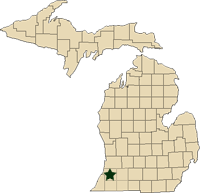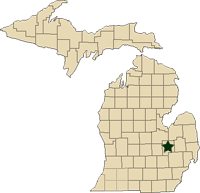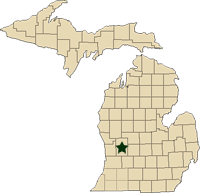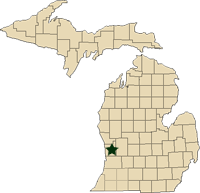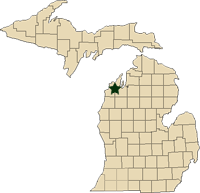Regional reports on Michigan fruit – March 27, 2012
MSU Extension educators’ pest and fruit updates for Michigan.
This week’s regional reports:
- Southwest Michigan - Mark Longstroth, Bill Shane, Diane Brown
- Southeast Michigan - Bob Tritten
- Grand Rapids Area Tree Fruit - Amy Irish Brown and Phil Schwallier
- Grand Rapids Area Small Fruit – Carlos García-Salazar
- Northwest Michigan - Nikki Rothwell, Duke Elsner, Erin Lizotte
Southwest Michigan – Mark Longstroth, Bill Shane, Diane Brown, Michigan State University Extension
|
Summer-like weather with highs near 80 and lows in the 50s ended Friday (March 23) with widespread rain showers and cooler temperatures. Rainfall totals ranged from a half-inch to 1.25 inches. Most areas received between 0.75 to 1.0 inches. The warm rains (60°F) were infection periods for several fruit diseases.
Cold, windy weather moved into the region on Sunday (March 25) and was followed by near freezing temperatures on Monday characterized by windy conditions and winds of about 10 mph. Temperatures were much warmer Tuesday morning.
This week it will be cooler with highs near 60s and lows generally below 40. This will slow down plant growth. Plant development is about a month ahead of normal. Soil temperatures have fallen from the 50s to the upper 40s. Soils are moist. Find a local weather station near you at Enviro-weather. Our growing degree day totals are currently three times higher than average. You can check summaries of weather or compare the current growing degree days between stations.
Tree fruit
The rapid bloom sequence last week had a different fruit species opening every day. The hot, dry conditions during bloom would have made early pollination of the flowers very important to set fruit. Some growers had problems getting bees quickly enough. The long wetting period Friday and Saturday was an infection period for brown rot and apple scab.
Apricots are in the shuck.
Peach bloom is ending. Pheromone disruption for oriental fruit moth should be in place by petal fall. This will help protect new shoots from the larvae. Brown rot can be a concern during the end with extended wetting periods. Nectarines should be protected against feeding damage caused by western flower thrips as fruit begin to fill the shuck. The tiny, 1/6-inch long brown thrip adults emerge from ground cover, produce larvae, and scar the young fruit. A hand lens may be needed to see the larvae within the shuck.
Tarnished plant bug damage may be a concern as the end of the developing peach or nectarine begins to stick out of the shuck. Monitoring for both thrips and tarnished plant bugs can help to determine the need for control measures.
Sweet cherries are still blooming. Watch for conditions favoring brown rot.
Tart cherries are at full bloom, which normally occurrs at the beginning May.
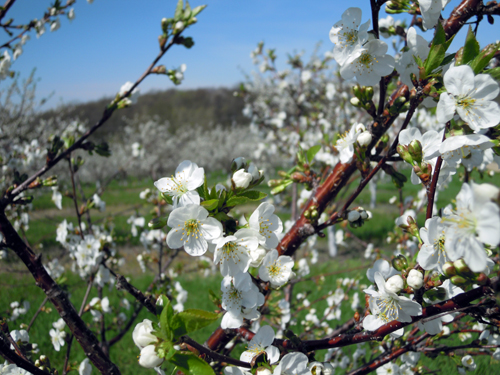
Cherries blooming last year on May 9, 2011. This is where they were Monday, March 26, 2012.
In plums, Japanese plums are in the shuck. European plums are blooming. Black knot requires wet conditions for infection.
Apples are at pink. Zestar bloom began Friday, March 23. Rain on Friday resulted in a widespread apple scab infection period across the region. Growers can use the scab infection tool on Enviro-weather to track when scab symptoms will be visible. No insecticides should be used at bloom time to prevent bee poisoning. Bloom signals the time to be monitoring conditions favoring fire blight – Enviro-weather has two methods for tracking fire blight episodes.
Pears are blooming. Growers will need to protect against pear scab and watch for fire blight conditions.
Small fruit
Grape buds have burst – some varieties are at second leaf, while some wine grape varieties are still at late swell. With the cool weather slowing down growth, growers should still be checking for cutworm and grape flea beetle injury.
Blueberries are at early pink bud. Friday’s rain was a mummy berry infection period. Mummy berry trumpets are scarce. Most of the trumpets observed last week were small. Growers should scout mummies for newly emerged trumpets and monitor the likelihood of rain and be ready to apply controls for mummy berry.
Strawberry flower trusses are emerging from the crown. Now is a good time to apply preemergent herbicides for early season weed control. Strawberries growing on black plastic are in bloom.
In brambles, leaves are unfolding. In the high tunnels at the Southwest Michigan Research and Extension Center, raspberry and blackberry leaves are expanding.
Upcoming meetings
There is a grower update in Van Buren County on Thursday, March 29 at the Lawrence Conference Center in Lawrence, Mich., at 6:30 p.m. There is a $5 charge. This meeting will address current insect and disease control concerns in blueberries, tree fruit and grapes.
Our regular Monday fruit meetings start on April 9 at Fruit Acres Farms at 5 p.m.
Southeast Michigan – Bob Tritten, Michigan State University Extension
|
Weather
A mass of cold air wept over southeast Michigan on Sunday evening (March 25), bringing widespread freezing temperatures on Monday evening and Tuesday morning to fruit farms. The coldest areas were from Lapeer, east to the Port Huron area, and then into the Thumb, with temperatures in the high teens and lower 20s. Fruit crops most at risk of freeze damage include peaches, sweet and tart cherries, and plums. All of these crops are at or near full bloom. Even apples, pears and blueberries in this region are at risk of loss of half of their flower buds. Temperatures in the rest of the region were generally in the mid-20s, and there is a good chance of significant flower bud loss in these areas. Every freeze and frost event is different; the unique feature of this event was the length of the cold event, with some farms seeing 12 hours of temperatures below 30°F.
Our early warm season is running at least a month ahead of normal in terms of growth stages, and even more than that in terms of degree day totals. In fact, degree day accumulations are six times their normal base 50 and 10 times normal for base 42 at many stations. Last week’s string of record-breaking temperatures pushed growth of what would normally take weeks into a few days. I do not see nearly as much spread in growth stages from south to north as I do most years. We are generally vulnerable to frost and freeze events for the next six to seven weeks.
Our soils remain very warm for this time of the season, with temperatures in the high 50s to low 60s most days. Warm soils have caused an abundance of weed seeds to geminate early this year. Soil moisture supplies are adequate thus far this season.
We have had excellent honeybee survival through the winter, with almost all hives surviving. This season we are having many fruit crops in bloom at the same time, all needing attention of honeybees.
|
Southeast Michigan Growing Degree Day Totals | |||
|
Location |
GDD42 |
GDD45 |
GDD50 |
|
Commerce (Oakland) |
289 |
240 |
166 |
|
Emmett (St Clair) |
272 |
225 |
155 |
|
Flint (Genesee) |
308 |
257 |
182 |
|
Lapeer (Lapeer) |
304 |
256 |
182 |
|
Petersburg (Monroe) |
306 |
255 |
177 |
|
Pigeon (Huron) |
259 |
214 |
150 |
|
Romeo (Macomb) |
273 |
224 |
151 |
Tree fruits
Apples are mostly at tight cluster with just an occasional bit of pink beginning to be seen. Spotted tentiform leafminer adults are being caught in low numbers. Red-banded leafrollers are being caught in high numbers. We are catching the normal number of apple scab spores at both of our monitoring stations. Some growers have not had an infection period, and others have had three infection periods.
Pears are at open cluster to early first white bud. Pear psylla adults have been flying for almost three weeks now, with egglaying taking place as well. Over the weekend I saw egg hatch just beginning to occur.
Peaches are at full bloom for most varieties. Brown rot sprays are going on.
Sweet cherries are at full bloom. Brown rot sprays are going on.
Tart cherries are mostly at first white to first bloom. There is not much spread this year between sweet cherry and tart cherry bloom. Brown rot sprays are going on.
Plums are mostly at full bloom for European types and petal fall for Japanese types. Brown rot sprays are going on.
Small fruits
Strawberry flower trusses have emerged from the crown at some farms, and at others only a few days from emerging. I am encouraging strawberry growers to leave straw mulch on the row as long as possible this season, mainly to delay bloom and therefore frost protection as long as possible. As soon as the flower clusters emerge from the crown, it is time to remove the straw mulch. I think that this time will be later this week for most strawberry growers in southeast Michigan.
Lastly, I am recommending that a bit more straw be left on the strawberry row this season than most years, as this will help reduce weed pressure and keep the bed cooler, thus delaying the beginning of harvest. I am seeing above average weed pressure in strawberries this season, especially chickweed and volunteer wheat.
Raspberry leaves continue to emerge for summer fruiting types and new canes continue to emerge from the soil for fall bearing types. I am also seeing heavy weed germination in fall bearing raspberries.
Blueberries are at tight cluster to early pink bud.
Grapes are at bud burst to 1 to 3 inches of shoot growth.
Grand Rapids Area Tree Fruit– Amy Irish Brown and Phil Schwallier, Michigan State University Extension
|
Growth stages
Most apples are now at the first pink stage depending on site and cultivar. The recent rain pushed growth even though temperatures are not quite as warm as last week. I expect full pink for most varieties at almost any time.
Peaches are in a late bloom stage and sweet cherries are in full bloom. Pears are in full bloom and fire blight will be a concern in the right weather conditions.
As far as degree days are adding up, we are 31 days ahead of average for base 32, plus 41 days for base 42 and 51 days ahead for base 50.
Pollination
If you haven’t checked with your bee person yet, you need to make that arrangement very soon. There are rumors of not being able to get bees to Michigan as fast as we will need them. You could also add bumblebee hives for added pollination and if the weather cools during bloom. Bumblebees will work in cold weather unlike honeybees.
Apple scab
The rain event Thursday, Friday and Saturday (March 22-24) resulted in a heavy apple scab infection for the Grand Rapids area. Rainfall totals were variable from just over a tenth of an inch to just over 1 inch. I checked spore rods Friday afternoon (March 23) and there were 607 spores per rod on average. When I checked them again Saturday afternoon, I only found 11 more that brought the total up to 618 for the entire wetting period. I’m not surprised that there were very few with the second round of rain because it really didn’t start up again until late in the day and most likely all the spores that were mature were released with the daytime rains. This seems like a large number, but I do have a very good site to monitor this year. I expect to catch tremendous numbers at this site this year.
Regardless, it tells me that primary apple scab spores are maturing and you need to really do a good job of keeping good fungicide covers on. I am a little concerned that with all the very fast growth we are likely to get in the next week and the heavy rainfall totals in some areas, that you do not want to risk stretching covers out too far. It would have been best for this rain to have had a full cover on.
Powdery mildew
We don’t usually worry about adding something to the tank for mildew this early in the game. However, the weather is very favorable for mildew. If you had blocks that had problems with mildew last year, it is likely that there are overwintering spore structures in the bud scales and they could be starting to germinate with all this warm weather. I recommend adding mildewcides in those problem blocks and for covers to varieties that are especially susceptible to mildew like Jonathan.
Cherry leafspot and brown rot
Cherry leafspot and brown rot in stone fruits are now a concern as bloom is opening. Apply fungicides as necessary to prevent.
Insects
Start thinking about what materials you might be using for you pre-bloom sprays in tree fruits. Remember that oil and Captan do not mix.
Grand Rapids Area Small Fruit– Carlos García-Salazar, Michigan State University Extension
|
The small fruit season started under very unusual circumstances – a short winter season and unexpected high temperatures at the beginning of spring 2012. According to the National Weather Service, February-March daily temperatures in 2012 are the hottest on record since 1880. Since Michigan’s fruit industry depends in many ways from climate conditions occurring during the winter and spring, these record temperatures are creating already unexpected challenges for the small fruit industry, especially for blueberry and strawberry production.
As of March 25, growing degree day (GDD) accumulation in west central Michigan since March 1 has reached 194 GDD (base 50°F). In this region, maximum daily temperatures have fluctuated between 85 and 67°F with minimum temperatures between 44 and 60°F. These unusual temperatures have advanced the growth and development of plants, insects and diseases by more than a month with respect to previous years.
Strawberries are growing rapidly. Growers are removing the straw mulching one month in advance. All strawberry fields are showing plants with newly emerging leaves growing from the crown of the plants. According to MSU Extension’s Bob Tritten, the typical time for removing straw in Michigan is mid- to late March for the lower half of the Lower Peninsula, mid- to late March for the northern half of the Lower Peninsula, and most likely early April in the Upper Peninsula. Under the current weather conditions, growers need to be aware that spring frosts may cause some damage once the mulch is removed and frost protection measures need to be considered to prevent extensive frost damage. See Tritten’s article, “Strawberry mulch removal time,” for more information.
For blueberries, early bud break increased the risks of frost damage. Blueberry development in the Grand Rapids area goes from the “tight cluster” growth stage to “early pink.” This is one month in advance with respect to 2010. Frost protection, if available, is required if sensitive bloom stages are already exposed.
Blueberry growers need to prepare their contingency plans to deal with possible freezing temperatures during the bloom period. Important elements of their plan include testing and calibration of the sprinkler irrigation system, testing and calibration of temperature recording devises, and water supply. One excellent training presentation on the basics of frost protection for fruit crops has been developed by the University of California, Davis Cooperative Extension.
There are indications that some frost damage already occurred in blueberry flower buds as a result of the low temperatures that occurred February 8-11 when the daily minimum temperatures fluctuated between 3 and 15°F. These temperatures caused some flower bud damage that average 14 percent. The damage can be seen as necrotic spots in the center of flower clusters. If you observe flower bud damage that you are not able to recognize, contact your localMSU Extension office for assistance before you take further actions. In Ottawa County, contact Carlos García at 616-260-0671. In Van Buren County, contact Mark Longstroth at 269-873-8983.
Northwest Michigan – Nikki Rothwell, Duke Elsner, Erin Lizotte, Michigan State University Extension
|
Weather and crop report
The unseasonably warm temperatures have pushed the northwest region of Michigan ahead of our five-year average by five to five and a half weeks. We had seven days of daytime temperatures in the mid-70s to the mid-80s, and nighttime temperatures remained high in the 60s and 70s last week. These warm conditions were followed by a rain event on Thursday night (March 22) and into Friday, where the region received about 0.4 inches of rain. Many growers were out spraying to cover for apple scab prior to this rain event.
Over the weekend, temperatures fell and overnight temperatures on Monday (March 26) were nerve-wracking as the thermometers read as low as 23.1°F. These cold temperatures lasted the duration of the evening (over six hours) and were coupled with high to moderate winds. As our fruit crops are all at different stages across the region, we are examining fruit buds for damage at this time. At the Northwest Michigan Horticultural Research Center (NWMHRC), we have observed little damage in sweet cherries, and we have variable damage reports for tart cherries depending on the stage of development. Thankfully, temperatures did not fall as low as the forecast predicted for Monday and into today (March 27) – temperatures hovered around 30 to 31°F, well above the low 20s that were forecasted. We have accumulated 269.7GDD base 42 and 157.7GDD base 50. These degree day accumulations are typical in the first week of May.
Growers are extremely busy due to the early season. They are trying to finish up their pruning for the season and are pushing brush to be able to get sprayers into blocks. Northwest Michigan had a wet, heavy snow storm on the weekend of March 3, and many growers are cleaning up the damage in Montmorency orchards; estimated losses are from 10 to 20 percent.
Pest report
Cherries. As we head into bloom in sweet cherry, growers are considering the pros and cons of treating for American brown rot with cool temperatures and the risk of crop damage from the overnight cold temperatures. Rovral is recommended for the spring, blossom-blight brown rot application to help limit the number of sterol inhibitor (SI) sprays used in a season in order to better manage against resistance development. Even though Indar has a 24(c) label for the 2012 season, the seasonal limit is still 48 oz, and if the season is warm and wet, growers may be challenged to control American brown rot with the limited amount of Indar. Rovral is an excellent material for American brown rot blossom blight and cannot be used past petal fall, so these early spring timings are optimal.
Regardless of the crop load, growers should plan to manage for cherry leaf spot and powdery mildew as green tissue emerges and becomes vulnerable. Adult green fruit worm moths were caught in the American plum borer traps, growers typically target green fruit worm larvae control at shucksplit; eggs and larvae will develop more slowly with the cool temperatures. The unusual weather patterns we are experiencing this year make comprehensive scouting even more critical.
Apples. Friday and Saturday’s (March 24-25) rain triggered an apple scab infection with many growers going into the event with green tissue covered. With the upcoming rains in the forecast, many area growers will likely be applying sprays ahead of the wetting event. During the 2008-2009 growing season, samples of apple scab were collected and strobilurin resistance in all major apple growing regions of the state was confirmed. It is important to remember that resistance to strobilurins conferred by the G143A mutation is complete, meaning that these fungi will not be controlled at all by this class of fungicides. Furthermore, increasing the rate of a strobilurin will not increase effectiveness – this is an all or nothing type of resistance.
EBDCs tank-mixed with captan is the recommended scab application during the season. EBDCs and Captan are both excellent scab protectants and provide five to six days of protectant activity when used at full rates. Growers should remember that spray intervals should be tighter when relying on these materials. Regardless of crop load, growers should carefully consider their scab management program as inoculum can build quickly over a season and make control difficult in subsequent seasons.
An average of four oriental fruit moth were also trapped at NWMHRC.



 Print
Print Email
Email